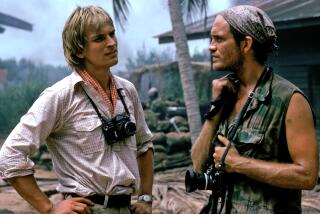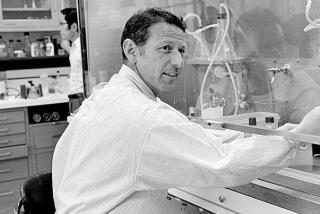Arthur Kornberg, 89; DNA pioneer
- Share via
Dr. Arthur Kornberg, the Stanford University Nobel laureate who was the first to synthesize DNA in a test tube and whose identification of the enzymes used by cells to manufacture DNA laid the foundation for the biotechnology industry, died of respiratory failure Friday at Stanford Hospital. He was 89.
A prolific researcher, Kornberg was also a gifted administrator who created the Stanford University School of Medicine’s biochemistry department, bringing in a talented and close-knit group of scientists who worked together for nearly half a century before they began to retire.
“It’s really the passing of a generation,” said Dr. Philip Pizzo, dean of the medical school. “Without doubt, his legacy will live on for many, many generations to come.”
Added Nobel laureate Paul Berg, “There have got to be tens of thousands of people around the world today whose eyes are tearing up with the news that he is gone. He was an extraordinary scientist. His accomplishments might be called legendary.”
Kornberg lived long enough to see his son Roger win the 2006 Nobel Prize in Chemistry, which ranked them with the Curies and a few others as one of the rare families to have more than one Nobel.
Given the remarkable manipulation of DNA that is common in research today, it is often hard to conceive how little was actually known about the mysterious molecule when Kornberg began his research in the 1950s. Scientists were pretty sure that it was the repository of genetic information, and they knew that the amounts of the bases cytosine and adenine in DNA were equal, as were the amounts of guanine and thymine.
Beyond that, DNA was a black hole.
Kornberg had been working at the National Institutes of Health in Bethesda, Md., during World War II when he developed an intense interest in enzymes, the large proteins used by cells to carry out chemical reactions, especially the synthesis of all the substances used by cells.
At war’s end, he apprenticed himself for a year in the laboratory of Severo Ochoa at New York University and for six additional months in the lab of Carl and Gerti Cori at Washington University in St. Louis to learn the difficult and time-consuming task of isolating enzymes from cells.
Cells contain thousands of enzymes in minute quantities, and isolating them requires patience and delicacy. At each stage of the purification process, researchers must check the enzymatic activity of their preparation to ensure that the desired compound is still there, then devise ever more sophisticated ways of separating proteins that are very similar to each other.
After some preliminary work isolating enzymes involved in vitamin production, he decided to tackle the more difficult challenge of DNA and RNA, the messenger molecule used by cells in the conversion of genetic information contained in DNA into proteins.
Kornberg reasoned that cells would produce DNA by stringing together pre-made nucleotides -- combinations of a base, a sugar molecule and a phosphate group. He therefore needed to know how to make nucleotides.
Abandoning animal tissue, he worked with yeast as a raw material, employing the new techniques of radioisotope labeling and ion-exchange chromatography to track reactions and products.
While Kornberg was working on the project in 1953, James Watson and Francis Crick published the structure of DNA, providing clues to direct his efforts.
By the following year, Kornberg and his colleagues had isolated the enzymes used to produce all five of the nucleotides used in RNA and DNA. They had also discovered that cells didn’t always synthesize nucleotides from scratch -- instead, they often used nucleotide fragments salvaged from the breakdown of old DNA or from digested food -- and the researchers identified enzymes that carried out those steps as well.
With the raw materials in hand, Kornberg began looking for the enzymes that stitched them together into DNA and RNA. In 1955, Ochoa announced the discovery of an enzyme that produced RNA -- although it was subsequently found to produce only an RNA-like chain -- and Kornberg shifted his focus to DNA synthesis.
By 1957, Kornberg had discovered and purified the key molecule, called DNA polymerase, and in October submitted two papers describing the work to the Journal of Biological Chemistry. Referees, however, objected to calling the material produced by the enzyme DNA, preferring the cumbersome term polydeoxyribonucleotide. One referee even insisted that the product must be shown to have genetic activity to be considered DNA.
Disgusted, Kornberg withdrew the papers, but they were published in May 1958 when the journal got a new editor.
His work confirmed speculation by Watson and Crick that genetic information was encoded in opposite directions on the two strands of double-helical DNA.
In 1959, Kornberg shared the Nobel Prize in Physiology or Medicine with Ochoa -- Kornberg for the synthesis of DNA and Ochoa for the synthesis of RNA.
Meanwhile, he was working to produce genetically active DNA. But because DNA from bacteria and more complex organisms was simply too big to be handled without damage using laboratory procedures then available, he turned to phages, tiny viruses that infect bacteria.
Other researchers had shown that the phages phi X174 and M13 were circular strands of DNA that, after entering bacterial cells, were converted into the well-known double helix. Kornberg was able to synthesize both phage genomes, but sealing the free ends together proved challenging. In 1967, Kornberg and four other research groups independently found the requisite enzyme, called DNA ligase, and by the end of the year he had produced an infectious phage.
Kornberg and the Stanford news bureau arranged a news conference on Dec. 14, 1967, timed to coincide with publication of the result in the Proceedings of the National Academy of Sciences. They took great pains to caution journalists not to characterize the feat as “synthesizing life in a test tube” because phages, like other viruses, are not capable of living outside cells.
President Johnson was scheduled to give a speech at the Smithsonian Institution the same day, and his aides asked Stanford for a paragraph about the DNA work.
As Johnson was reading the prepared statement, he abruptly put it aside and told the audience, “Some geniuses at Stanford University have created life in the test tube!” To Kornberg’s dismay, all the newspaper stories the next day began with that statement.
As Kornberg continued working with DNA polymerase, he found that it could also repair damaged DNA, leading some scientists to question whether it was truly the enzyme responsible for DNA replication. Further questions arose when John Cairns discovered an Escherichia coli mutant that could reproduce normally without the enzyme.
Kornberg was vindicated in 1971 by his son, Thomas, a talented cellist who had been studying at the Juilliard School until a hand injury ended his career and shunted him toward science. Thomas Kornberg isolated a second DNA polymerase from the mutant that was quite different in structure from the original DNA polymerase but equally capable of synthesizing and editing DNA. The following year, he found a third DNA polymerase as well.
The enzymes isolated by Arthur Kornberg and his colleagues were crucial to the development of recombinant DNA technology, which is the underpinning of the biotechnology industry.
Arthur Kornberg was born in New York City on March 13, 1918. His parents immigrated to the United States in 1900 from what is now Poland before they were married.
His father Joseph, who spoke at least six languages even though he had no formal education, worked as a sewing machine operator on Manhattan’s Lower East Side for almost 30 years. When his health failed, he opened a small hardware store in Brooklyn, where Kornberg, then 9, served customers.
Kornberg skipped three grades in school and at age 15 entered the City College of New York. He didn’t recall a passion for science -- he collected matchbook covers rather than butterflies. He did well in chemistry in high school and college and considered an academic career in it, but in the midst of the Great Depression, medicine seemed a better choice, and he received his medical degree from the University of Rochester in 1941.
He had an elevated level of bilirubin in his blood and mild jaundice because of a genetic condition known as Gilbert’s syndrome. While in medical school, he surveyed his fellow medical students to discover how common the condition was and submitted a paper, which was published in 1942.
After an internship in Rochester, N.Y., Kornberg became a lieutenant in the U.S. Coast Guard, serving as a ship’s doctor in 1942.
But when his paper was published that year, it came to the attention of Rolla Dyer, director of the National Institutes of Health, who was desperately seeking information about jaundice because of an outbreak caused by the yellow fever vaccine. Dyer recruited Kornberg and set him to work studying vitamin deficiencies in rats.
The rodents, which were fed a minimal diet containing nutrients and all the vitamins then known, were fine until they were given sulfa antibiotics, which induced an often fatal blood disorder. The disorder could be avoided or cured if the rats were given regular rations or liver supplements.
Kornberg found that the sulfas were structurally similar to a precursor of folic acid and prevented the manufacture of folic acid by intestinal bacteria. He thus demonstrated that folic acid was an essential nutrient. He also showed that the sulfas prevented formation of vitamin K by the bacteria.
By 1953, he feared cutbacks in funding at the NIH and became head of the department of microbiology at Washington University. The cutbacks did not occur, however, and Kornberg remained a strong supporter of the NIH throughout his career.
In 1959, Kornberg became head of the new biochemistry department at Stanford, taking many of his fellow Washington University faculty members with him. The original faculty members, including Berg, Robert Baldwin, David Hogness, Dale Kaiser and Robert Lehman, remained the core of the department for nearly 50 years, sharing laboratory space and ideas.
In the process, Stanford became one of the first medical schools to shift from merely teaching prospective doctors to exploring the causes and prevention of disease.
In 1943, he married Sylvy Ruth Levy, a talented biochemist he had met at the University of Rochester. With the exception of six years spent raising their young children, she spent her career working in his laboratory until her death in 1986.
When Kornberg received his Nobel, she was famously quoted as saying, “I was robbed.”
In 1988, he married Charlene Walsh Levering, who died in 1995. In 1998, he married Carolyn Frey Dixon.
In addition to his wife, he is survived by sons Roger, a professor of structural biology at Stanford; Thomas, a professor of biochemistry and biophysics at UC San Francisco; and Kenneth, an architect and founder of laboratory design firm Kornberg Associates of Menlo Park and San Diego; and eight grandchildren.
Stanford will host a celebration of Kornberg’s life and legacy; details are forthcoming.
--






